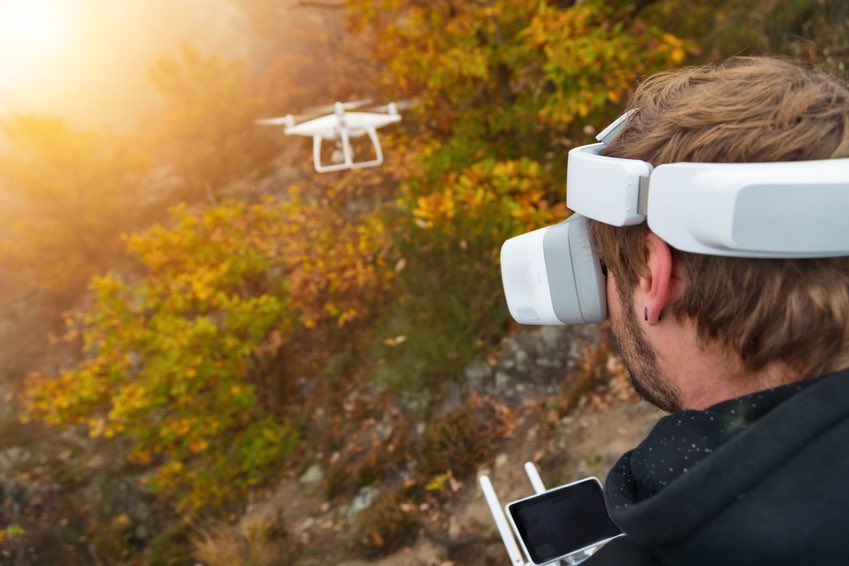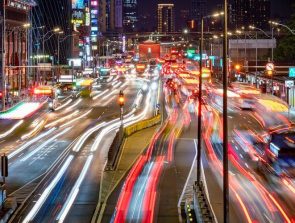FPV Flying for Beginners
Traditionally, quadcopters or drones, as they are more commonly known, are flown using the line-of-sight method. The pilot looks at the drone from their position on the ground, assesses its position remotely, and controls its movements accordingly. The main drawback of this method is that you can only fly the drone as far as your line of sight allows. In cloudy or foggy conditions, this can be as short as half a mile.
Controlling from the ground can also be quite clunky, with the right and left directions reversing based on the relative position of the drone. Additionally, the farther away the drone, the harder it is to control it.
What can be done to overcome the limits of the line-of-sight method? Enter FPV flying.
What is FPV Flying?
FPV stands for First Person View, meaning you have a first person view directly from the drone giving a feeling like piloting an actual aircraft. You can see exactly what the drone is seeing in real-time, providing a completely different and highly immersive experience. Depending on the technology, you can even customize the field of vision to increase your awareness of your drone’s surroundings.
Due to the first-person perspective, the right and left directions are never reversed. It is near-impossible for you to lose track of the location of your drone. GPS technologies can also help towards keep track of the drone. The increased sense of orientation and spatial awareness also allows you to fly faster and more aggressively, as may be necessary in drone racing. Another worthwhile advantage of FPV flying is that it gives you more control in taking aerial photos or footage.
Simply put, FPV flying can give you an incredibly immersive flight experience, which will certainly leave you wanting more.
Rounding up the Essentials
A rig that allows for FPV flying is made up four essential parts: (1) a video transmitter, (2) a video receiver, (3) a camera, and (4) a display. Pre-packaged drones may be purchased that readily provide the technology for FPV flying, such as the DJI Phantom 4 or Blade Nano QX2. Conversely, and for greater customization, you can build your own FPV-ready setup using individual components.
- Video Transmitter – There are typically four frequencies at which an FPV video feed can be transmitted: 900MHz, 1.2 GHz, 2.4 GHZ, and 5.8 GHz. The most commonly used frequencies in the field of drone flight are 2.4 GHz and 5.8 GHz (commonly known as the “Fat Shark” frequency alluding to its compatibility to the popular brand of video goggles). It may be worthwhile to check with local regulations on which frequency is available for unlicensed use. Usually, there are eight or more channels in a frequency, allowing several people to fly their drones without interfering with each other. Anyone within the range of the frequency can also gain access to your video feed, giving them “spectator” access to your FPV flight.
- Video Receiver – This is a fairly simple matter, as a video receiver comes packaged with the transmitter upon purchase.
- Camera – An ideal camera for FPV flight has two qualities: lightweight, and gives good image quality. A bulky and heavy camera will weigh down your drone, draining your battery quickly or possibly even preventing your drone from taking off. A camera with good image quality is also crucial in providing a more fulfilling FPV experience while making navigation easier.
- Display – The FPV video feed can be displayed either on an FPV Display or on FPV Goggles. What’s the difference between the two? The FPV Display shows the video feed on a screen similar to a tablet. Some models have the display built in directly onto the transmitter or control module, such as the Hubsan X4 Quadcopter with FPV Camera or Hubsan H501S X4 FPV. FPV Displays are less immersive, but are more affordable than FPV Goggles.
FPV Goggles probably represent the peak level of immersion of FPV flying as we know it today. Due to the unequaled level of immersion and fun of the full experience of FPV flight, it is the display of choice of drone enthusiasts. Aside from the fun factor, the use of FPV Goggles also eliminates the problem of glare when flying in sunny weather resulting in more convenience and flexibility.
A couple of factors should be considered in the choice of FPV Goggles. Most of them are quite expensive, with the cheapest models going for around $100. High quality models are more recommended, but these can cost upwards of $500.
A higher field of view is recommended, as it decreases the chances of a crash and is simply more fun. The widest field of view available is ideal, but 30 degrees or more is considered a good number.
For a more fulfilling FPV experience, a screen resolution of at least 640 x 480 is recommended, even if this means paying a little bit extra.
A head tracking feature, while not absolutely necessary, is highly recommended as it is a lot more fun and gives a better flying experience. With this feature, the camera mounted in the drone tilts and rotates according to your head movement.
Tips for FPV Flying
- Practice the basics first… – Flying using FPV technology represents a more advanced level of drone flight. Thus, the importance of learning the basics of drone flying cannot be stressed enough. You do not want to spend on a more expensive FPV-ready drone just to have it crash immediately. For practice flights, it may be more practical to buy cheaper and easy to control models such as the Cheerson CX-10. The slightly more expensive Altair Aerial AA108 is another good choice for beginner flying due to its excellent durability and ease-of-use.
- …then practice FPV flight – FPV flight is an entirely different animal compared to line-of-sight flight, especially when using FPV Goggles. It can be quite tricky at first, as looking at the world through a camera lens can throw off your depth perception. Objects seen through the FPV Goggles can actually be closer than they seem and this discrepancy can cause a crash. It will likely take some practice before you can fly fast and aggressive in FPV.
- Have a spotter – When flying using FPV, you can become blissfully unaware of obstacles and other hazards just outside the scope of your camera. It is prudent to have a “spotter” nearby who has line-of-sight perspective of your drone and can warn you when you’re getting too close to an obstacle. Take note that as part of drone flight etiquette, it is recommended that you and your spotter partner switch roles at agreed intervals.
- Know and respect your laws – Although FPV flight enables you to fly your drone beyond your line-of-sight, note that this is prohibited under most local laws. The FAA created the Line-of-Sight Mandate, which dictates that you can only fly your drone within the range of eyesight. Practice responsibility and restraint when flying using FPV. With the corresponding penalties of breaking FAA regulations (a fine or confiscation of your drone), it is simply not worth the risk.
- Fly in safe surroundings – Not all types of surroundings are safe or practical for any type of drone flight. Places with a high density of tall buildings, electrical wires, or birds, are very likely to be places where your drone will encounter an obstacle and crash. Try not to fly over areas where finding your drone will be difficult should it crash, such as heavily forested areas or bodies of water. It is also considered rude and very dangerous to fly your drone over people. Large open spaces, such as beaches, deserts, or parks, are most recommended for drone flight. Again, it is worthwhile to check with your local laws to ensure that you are flying your drone where you are legally allowed.
The final word
FPV flying can introduce an entirely different dimension of immersion and fun to drone flight. However, at such a steep price tag, it is encouraged to practice due diligence and to know your priorities before diving into the field of FPV flight. As with drone flight in general, responsible practice needs to be followed to ensure your safety, the safety of your drone, the safety of your surroundings, and the safety of the people around you.


